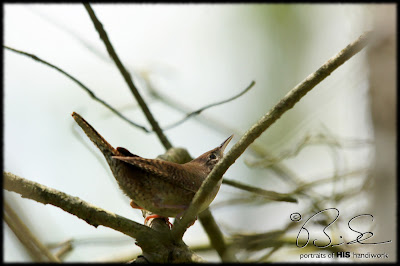I was on the south side of St. George cutting and lugging home a few cords from a huge, old Beech tree which the hydro company had taken down in a big wire protection campaign they did in the area. While feeding the thirsty chainsaw or filling the trailer with wood, consistently I was hearing a persistent, unfamiliar bird call. On my last load, I brought the camera with me and decided to push into the neighbouring woods which also backs on to an adjacent golf course. But before I could circle in on the source, I heard and then spotted a Eastern Wood-Pewee. Their distinctive "PEE-ah-WEE" call gives them away, but they are small and like the tree tops, so I've not gotten a close look before. This one seemed curious about me, so although not really close, I could get a nice look and some closer shots.
 |
| Eastern Wood-Pewee |
 |
| Eastern Wood-Pewee |
Ironically, my circling in on the original singer lead me back to where I started, and I finally found the little creature who had been singing along with my chainsaw all day. It was a cute little House Wren (life bird #124 - I skipped this one). Unfortunately my vantage of the bird was through other underbrush and I couldn't seem to get a good angle, so I had to switch to manual focus and in low light, that didn't prove to result in many good pictures that were in focus.
 |
| House Wren |
One other sight I spotted was a thoroughly tapped Pine tree by a Sapsucker. I had "borrowed" and posted a photo from another website previously when I saw my first Yellow-bellied Sapsucker, but now I have my own picture to share.
 |
| Yellow-bellied Sapsucker food site. |
Again close to home, there is an old sewage lagoon from the old Carnation condense milk plant in St. George which has since been closed. And the sewage lagoon has also been decommissioned and reduced to a small fraction of its original size. They basically excavated a big outlet in the original banks they had constructed years ago and left a shallow area of water to remain. The location was still suitable for a small group of about 10 Canada Geese, and a little mixed flock of shore birds. About three or four Spotted Sandpipers were courting each other and wading along the water's edge.
 |
| Spotted Sandpiper |
 |
| Spotted Sandpiper courting "chase" |
There was also a small group of four Killdeer there, and they seemed to be very busy with a prolonged argument. If it's possible to tell male and female, I certainly don't know, so I'm not sure if this was a territory or mating battle, but the four would all slowly approach on each other and then one would make an aggressive move on one of the other in the group and they'd all wing a short retreat back. It was repeated over an over again.
 |
| Killdeer |
 |
| Killdeer standoff |
The next few pictures have been quite a mystery to me. A few of you received emails from me asking for your advice.
 |
 |
At first, I thought I had a Semipalmated Sandiper. But the beak seemed too long, and too pointed. Some of you suggested Western (I try not to get myself excited about rare finds, of which that would be for this area) so I didn't really consider it.White-rumped was also considered but discounted because the wings don't seem to pass the tail really. I was leaning to a juvenile Western though after lots of looking on the web. For good measure I thought I'd ask the Hamilton Birders Group, and it seems the consensus is that it's a juvenile or female Sanderling. That does seem to fit best and be most likely, though I still feel like the beak looks to long. So, to be conservative, I'll stick with that ID and forgo an exciting new life bird tick.
 |
Thanks to everyone (Dwayne, Peter, Caleb, Wayne, Gerry) for their input. Although somewhat frustrating not being able to come out with a clear ID, I think I learned a number of "peep" traits that hopefully will help in IDing them better in the future.
UPDATE: I received an email this morning from Kevin McLaughlin (who I understand is more than qualified on peeps) that female Semipalmated Sandpipers are known to have beaks that are almost as long as the Western Sandpipers. So, based on that new information, I think I have a firm ID and learned something new in the process. Thanks Kevin.
And, the moral of this post is, don't ignore the little spots close to home... there's likely more bird life hanging out there than you might think, even if it doesn't seem so exotic to burn gas getting to somewhere "else".
Keep enjoying His handiwork!

No comments:
Post a Comment
Sorry about the annoying word verification... I've been deluged with Spam comments lately and some have been offensive.